If you have logged into MongoDB Atlas recently – and you should, the entry-level tier is free! – you may have noticed a strange new syntax on 3.6 connection strings.
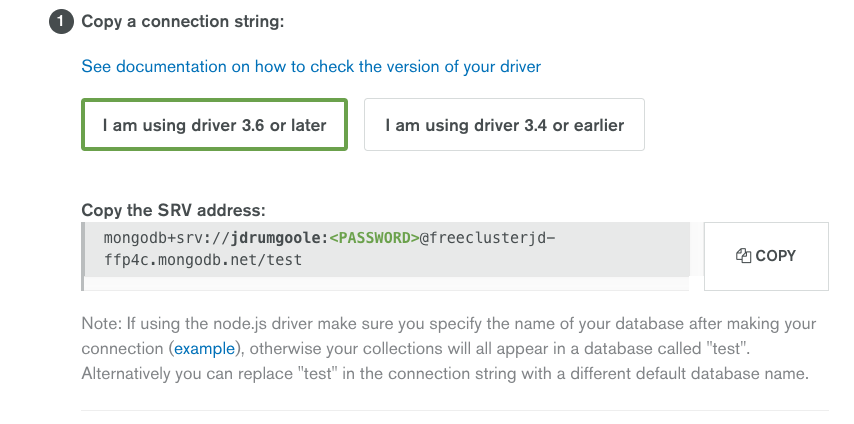
MongoDB Seed Lists
What is this mongodb+srv syntax?
Well, in MongoDB 3.6 we introduced the concept of a seed list that is specified using DNS records, specifically SRV and TXT records. You will recall from using replica sets with MongoDB that the client must specify at least one replica set member (and may specify several of them) when connecting. This allows a client to connect to a replica set even if one of the nodes that the client specifies is unavailable.
You can see an example of this URL on a 3.4 cluster connection string:
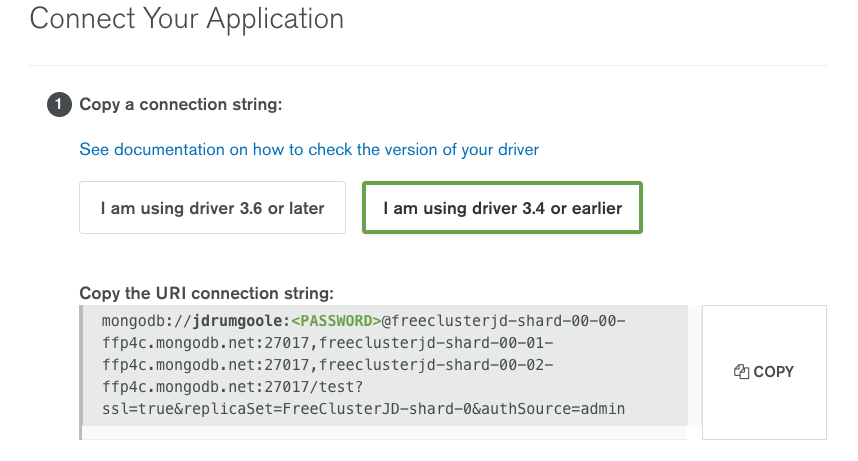
ssl and replicaSet options.

With the 3.4 or earlier driver, we have to specify all the options on the command line using the MongoDB URI syntax.
The use of SRV records eliminates the requirement for every client to pass in a complete set of state information for the cluster. Instead, a single SRV record identifies all the nodes associated with the cluster (and their port numbers) and an associated TXT record defines the options for the URI.
Reading SRV and TXT Records
We can see how this works in practice on a MongoDB Atlas cluster with a simple Python script.
import srvlookup #pip install srvlookup
import sys
import dns.resolver #pip install dnspython
host = None
if len(sys.argv) > 1 :
host = sys.argv[1]
if host :
services = srvlookup.lookup("mongodb", domain=host)
for i in services:
print("%s:%i" % (i.hostname, i.port))
for txtrecord in dns.resolver.query(host, 'TXT'):
print("%s: %s" % ( host, txtrecord))
else:
print("No host specified")
We can run this script using the node specified in the 3.6 connection string as a parameter.

$ python mongodb_srv_records.py freeclusterjd-ffp4c.mongodb.net freeclusterjd-shard-00-00-ffp4c.mongodb.net:27017 freeclusterjd-shard-00-01-ffp4c.mongodb.net:27017 freeclusterjd-shard-00-02-ffp4c.mongodb.net:27017 freeclusterjd-ffp4c.mongodb.net: "authSource=admin&replicaSet=FreeClusterJD-shard-0" $
You can also do this lookup with nslookup:
JD10Gen-old:~ jdrumgoole$ nslookup > set type=SRV > _mongodb._tcp.rs.joedrumgoole.com Server: 10.65.141.1 Address: 10.65.141.1#53 Non-authoritative answer: _mongodb._tcp.rs.joedrumgoole.com service = 0 0 27022 rs1.joedrumgoole.com. _mongodb._tcp.rs.joedrumgoole.com service = 0 0 27022 rs2.joedrumgoole.com. _mongodb._tcp.rs.joedrumgoole.com service = 0 0 27022 rs3.joedrumgoole.com. Authoritative answers can be found from: > set type=TXT > rs.joedrumgoole.com Server: 10.65.141.1 Address: 10.65.141.1#53 Non-authoritative answer: rs.joedrumgoole.com text = "authSource=admin&replicaSet=srvdemo"
You can see how this could be used to construct a 3.4 style connection string by comparing it with the 3.4 connection string above.
As you can see, the complexity of the cluster and its configuration parameters are stored in the DNS server and hidden from the end user. If a node’s IP address or name changes or we want to change the replica set name, this can all now be done completely transparently from the client’s perspective. We can also add and remove nodes from a cluster without impacting clients.
So now whenever you see mongodb+srv you know you are expecting a SRV and TXT record to deliver the client connection string.
Creating SRV and TXT records
Of course, SRV and TXT records are not just for Atlas. You can also create your own SRV and TXT records for your self-hosted MongoDB clusters. All you need for this is edit access to your DNS server so you can add SRV and TXT records. In the examples that follow we are using the AWS Route 53 DNS service.
I have set up a demo replica set on AWS with a three-node setup. They are :
rs1.joedrumgoole.com rs2.joedrumgoole.com rs3.joedrumgoole.com
Each has a mongod process running on port 27022. I have set up a security group that allows access to my local laptop and the nodes themselves so they can see each other.
I also set up the DNS names for the above nodes in AWS Route 53.

$ sudo /usr/local/m/versions/3.6.3/bin/mongod --auth --port 27022 --replSet srvdemo --bind_ip 0.0.0.0 --keyFile mdb_keyfile"
Now we need to set up the SRV and TXT records for this cluster.
The SRV record points to the server or servers that will comprise the members of the replica set. The TXT record defines the options for the replica set, specifically the database that will be used for authorization and the name of the replica set. It is important to note that the mongodb+srv format URI implicitly adds “ssl=true”. In our case SSL is not used for the demo so we have to append “&ssl=false” to the client connector. Note that the SRV record is specifically designed to look up the mongodb service referenced at the start of the URL.
The settings in AWS Route 53 are:
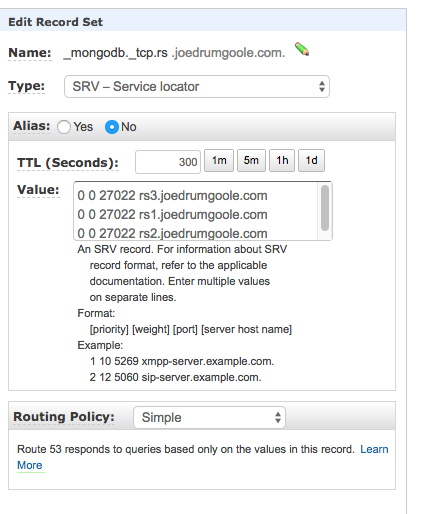

rs.joedrumgoole.com) so that MongoDB knows where to find the TXT record.
We can do this on AWS Route 53 as follows:
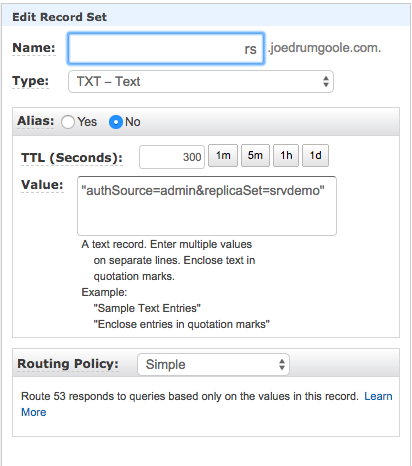

mongodb+srv://rs.joedrumgoole.com/test
This will retrieve a complete URL and connection string which can then be used to contact the service.
The whole process is outlined below:
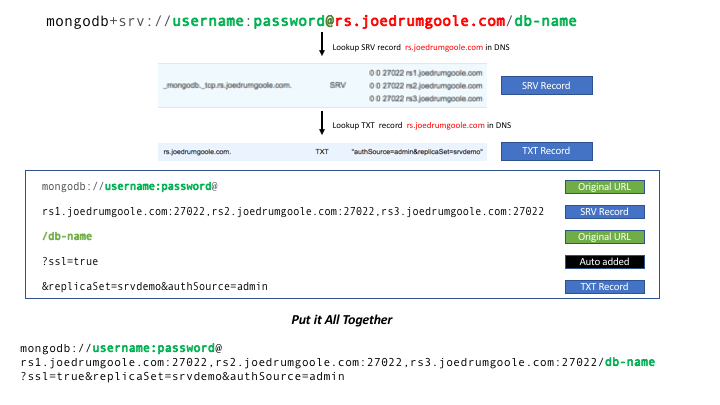
SRV records are another way in which MongoDB is making life easier for database developers everywhere.
You should also check out full documentation on SRV and TXT records in MongoDB 3.6.
You can sign up for a free MongoDB Atlas tier which is suitable for single user use.
Find out how to use your favorite programming language with MongoDB via our MongoDB drivers.
Please visit MongoDB University for free online training in all aspects of MongoDB.
Follow Joe Drumgoole on twitter for more news about MongoDB.